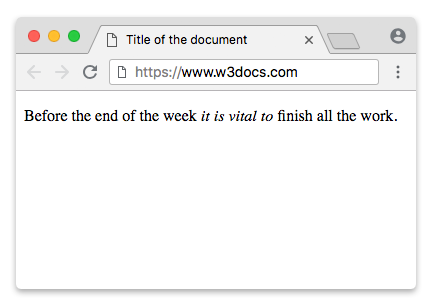The <i> tag is used to define a part of the text in a different voice. The text placed within the <i> tag is usually displayed in italic. This tag is used to define technical terms, phrases from foreign languages, etc.
The <i> tag is an element of a physical markup, that is, the embedded text differs only visually and is not perceived as important by browsers and search engines.
In the earlier specification, the <i> tag was just a presentational element that was used to show a text in italic. But now it defines the semantics and not the typographic display. If not defined, browsers can still display the content of the <i> tag in italic. If you want to style the content in italic, it’s better to use the CSS font-style property instead of <i>.
Sometimes you may need to use other, more appropriate elements:
Syntax
The <i> tag comes in pairs. The content is written between the opening (<i>) and closing (</i>) tags.
Example of the HTML <i> tag:
<!DOCTYPE html>
<html>
<head>
<title>Title of the document</title>
</head>
<body>
<p>Before the end of the week <i>it is vital to</i> finish all the work.</p>
</body>
</html>Result

Attributes
The <i> tag supports the Global Attributes and the Event Attributes.
How to style <i> tag?
Common properties to alter the visual weight/emphasis/size of text in <i> tag:
- CSS font-style property sets the style of the font. normal | italic | oblique | initial | inherit.
- CSS font-family property specifies a prioritized list of one or more font family names and/or generic family names for the selected element.
- CSS font-size property sets the size of the font.
- CSS font-weight property defines whether the font should be bold or thick.
- CSS text-transform property controls text case and capitalization.
- CSS text-decoration property specifies the decoration added to text, and is a shorthand property for text-decoration-line, text-decoration-color, text-decoration-style.
Coloring text in <i> tag:
- CSS color property describes the color of the text content and text decorations.
- CSS background-color property sets the background color of an element.
Text layout styles for <i> tag:
- CSS text-indent property specifies the indentation of the first line in a text block.
- CSS text-overflow property specifies how overflowed content that is not displayed should be signalled to the user.
- CSS white-space property specifies how white-space inside an element is handled.
- CSS word-break property specifies where the lines should be broken.
Other properties worth looking at for <i> tag:
- CSS text-shadow property adds shadow to text.
- CSS text-align-last property sets the alignment of the last line of the text.
- CSS line-height property specifies the height of a line.
- CSS letter-spacing property defines the spaces between letters/characters in a text.
- CSS word-spacing property sets the spacing between words.
Browser support
|
|
|
|
|
|
|---|---|---|---|---|
| ✓ | ✓ | ✓ | ✓ | ✓ |
Practice Your Knowledge
Quiz Time: Test Your Skills!
Ready to challenge what you've learned? Dive into our interactive quizzes for a deeper understanding and a fun way to reinforce your knowledge.